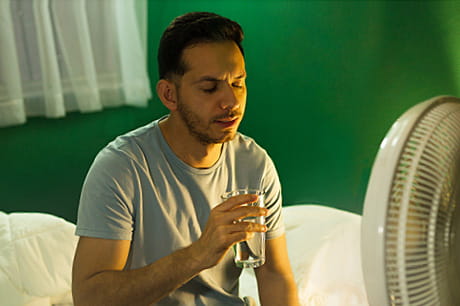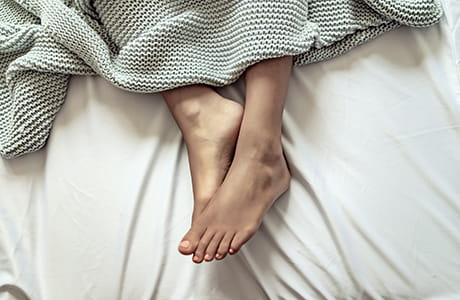
Sleep disorders
Understand the conditions that could be keeping you up at night.
Don’t let poor sleep hold you back.
There are over 70 different sleep disorders. Good sleep isn’t just a matter of getting enough sleep hours. Proper sleep quality and timing is important, too. While improving your sleep habits may be helpful in some cases, the majority of sleep disorders require treatment for improved sleep.
If you’re concerned about your sleep, talk to your doctor to make sure you get the care you need. The Sleep to Be Well surveys and sleep diary can help you prepare for the discussion.

Common sleep disorders
One sign of narcolepsy in teens and kids is excessive daytime sleepiness. But your child can also have symptoms like:
- Falling asleep suddenly
- Muscle weakness or loss of control
- Temporary inability to move or speak
- Excessive or unregulated waking and dreaming at night
Many teens with narcolepsy may have a very hard time sticking to a regular sleep and exercise schedule.
Parasomnias are the result of transitions between sleep and wake. Parasomnias can include symptoms such as:
- Sleep terrors
- Confusional arousals
- Sleep talking
- Sleep walking
- Sleep eating
If you’re concerned about parasomnias, talk to your doctor.
You may consider the following to improve the frequency and severity of events:
- Don’t have someone wake you during the parasomnia episodes, as it can prolong or worsen the event.
- Waking up at scheduled times may be appropriate for predictable, chronic and severe parasomnias.
- Maintaining a regular sleep schedule 7 days a week can improve frequency of episodes.
Safety measures are critical to avoid injury during the parasomnia event and may include the following:
- Clearing the bedroom of obstructions
- Securing doors and windows
- Placing the mattress on the floor
- Sleeping on the first floor to avoid falling down stairs
- Installing locks and/or alarms on windows and doors
- Covering windows with heavy curtains to limit light that causes awakenings
A sleep study isn’t needed to diagnose parasomnia. But one may be ordered if there’s a concern that other sleep issues may be worsening the condition.
Sleep disordered breathing or sleep apnea involves difficulty breathing, which then disrupts sleep. There are a few different types of sleep apnea:
- Obstructive sleep apnea: This is the most common type, and it involves a complete or partial obstruction of your airway while you sleep. Obstructive sleep apnea causes you to nearly or completely stop breathing while sleeping.
- Central sleep apnea: This neurological condition leads to disrupted breathing while you sleep.
- Mixed sleep apnea: This condition is a blend of both obstructive and central sleep apnea.
People with symptoms of sleep disordered breathing should be evaluated with a sleep study. Sleep apnea may be treated with a positive airway pressure device (PAP), body weight optimization, positional therapy, oral appliances or surgical interventions including a hypoglossal nerve stimulator.
Nightmare disorder involves undesirable experiences while you're falling asleep, during sleep or when you're waking up.
Nightmares can be triggered by many factors, including:
- Stress or anxiety. Sometimes the ordinary stresses of daily life, such as a problem at home or school, trigger nightmares. A major change, such as a move or the death of a loved one, can have the same effect. Anxiety is associated with a greater risk of nightmares.
- Trauma. Nightmares are common after an accident, injury, physical or sexual abuse or other traumatic event. Nightmares are common in people who have post-traumatic stress disorder (PTSD).
- Sleep deprivation. Changes in your schedule that cause irregular sleeping and waking times or that interrupt or reduce the amount of sleep you get can increase your risk of having nightmares. Insomnia is associated with an increased risk of nightmares.
- Medications. Some drugs — including certain antidepressants, blood pressure medications, beta blockers, and drugs used to treat Parkinson's disease or to help stop smoking — can trigger nightmares.
- Substance misuse. Alcohol and recreational drug use or withdrawal can trigger nightmares.
- Other disorders. Depression and other mental health disorders may be linked to nightmares. Nightmares can happen along with some medical conditions, such as heart disease or cancer. Having other sleep disorders that interfere with adequate sleep can be associated with having nightmares.
- Scary books and movies. For some people, reading scary books or watching frightening movies, especially before bed, can be associated with nightmares.
One potential treatment for nightmare disorders is called imagery rehearsal therapy (IRT).
Sleep-related movement disorders are repetitive movements during sleep or just before falling asleep.
Some common types include:
- Teeth grinding
- Restless leg syndrome
- Sleep rhythmic movement disorder


How's your sleep?
Complete our short sleep surveys to receive instant feedback on whether your sleep is on the right track or if there’s room for improvement.




